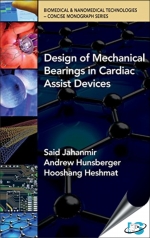Tab Article
Up to 40 volumes are planned for this concise monograph series, which focuses on the implementation of various engineering principles in the conception, design, development, analysis and operation of biomedical, biotechnological and nanotechnology systems and applications.
Continuous flow, mechanical cardiac assist devices rely on a rotating impeller to aid the heart with blood flow. Like any other mechanical system, the rotating components of these devices require some form of load support that is provided by either mechanical or magnetic bearings. The goal of this monograph is to provide an overview of basic principles that are important for design and evaluation of mechanical bearings used in blood pumps, with a primary focus on mechanical bearings used in the second and third generation ventricular assist devices (VADs). A general introduction of some basic principles that are important for design of mechanical bearings is first provided. The basic function of lubricants is described and a brief introduction is provided for surface roughness and the concept of real area of contact. Different lubrication regimes (boundary, mixed and fluid film) are defined. Rheological properties of different types of fluids are described.
In the boundary lubrication regime contact lubrication is controlled by the physical and chemical properties of thin films, whereas in the hydrodynamic lubrication regime only physical and rheological properties of the thick fluid films are important. Principles of hydrodynamic lubrication are described and different types of fluid film bearings are discussed. Reynolds Equation which is the fundamental base for fluid film lubrication is discussed and its application to the design of different types of bearings is explored. An example for the design of a blood lubricated thrust bearing is provided. Lubrication of contact bearings is described and some challenging is-sues such as contact damage are briefly introduced. Boundary lubrication with molecular films is described. Fundamental mechanisms of wear and damage formation as well as the use of hard ceramic materials to combat wear are described. Finally examples are provided for current assist devices where blood lubricated contact bearings or hydrodynamic bearings are used.


